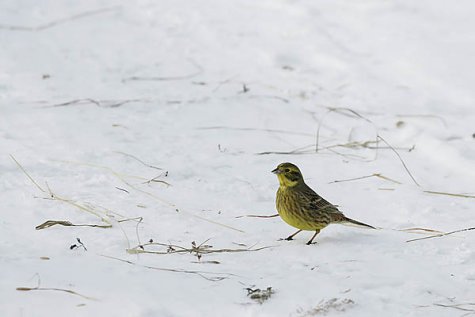About bunting flocks
Photo: Arne Ader
Translation Liis
Bunting
Bunting Talvike Emberiza citrinella
Buntings can be seen moving in groups during daytime in the forest camera feeding ground, often together with tree sparrows. At the bird feeders we also meet them: there they prefer to feed on the ground. We can also see them at roadsides or in groups sitting on power lines, in fields or meadows looking for weed seeds, in thickets and broadleaf trees feeding on seeds.
Buntings are passerines with small beaks and comparatively long tails; length about 15 centimetres and weight 30 grams, thus a little bigger than tree sparrows. The edges of the tail feathers white, the little beak bluish, legs light yellowish brown.
The plumage colour of buntings can vary between individuals: back and wing plumage brown and black-banded, rump area rust-brown and on the chest we can also notice darker bands. The head of the male is noticeably yellow, the plumage of the female more modest but the breast plumage more banded. The more the day turns towards spring the more ”golden” the plumage of buntings turns.
Passing migrants are seen in great numbers in March; then we hear their quiet, simple but easily recognisable song: tsi-tsi-tsi-tsi-tsi-tsi…. Up to a couple of hundred thousand bunting pairs remain in Estonia to breed.
Bunting observations: LINK









